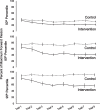Reducing lumbar spine flexion using real-time biofeedback during patient handling tasks
- PMID: 32417812
- PMCID: PMC7369082
- DOI: 10.3233/WOR-203149
Reducing lumbar spine flexion using real-time biofeedback during patient handling tasks
Abstract
Background: Patient handling activities require caregivers to adopt postures that increase the risk of back injury. Training programs relying primarily on didactic methods have been shown to be ineffective at reducing this risk. The use of real-time biofeedback has potential as an alternative training method.
Objective: To investigate the effect of real-time biofeedback on time spent by caregivers in end-range lumbar spine flexion.
Methods: Novice participants were divided into intervention (n = 10) and control (n = 10) groups and were asked to perform a set of simulated care activities eight times on two consecutive days. Individuals in the intervention group watched a training video on safer movement strategies and received real-time auditory feedback from a wearable device (PostureCoach) in four training trials whenever their lumbar spine flexion exceeded a threshold (70% of maximum flexion). Changes in end-range lumbar spine flexion were compared between groups and across trials.
Results: Participants in the intervention group saw reductions in end-range lumbar spine flexion during the simulated patient handling tasks at the end of the training compared to their baseline trials while there was no change for the control group.
Conclusions: The training program including PostureCoach has the potential to help caregivers learn to use safer postures that reduce the risk of back injury.
Keywords: PostureCoach; family caregivers; low back pain; multi-component training intervention; personal support workers.
Conflict of interest statement
None to report.
Figures








Similar articles
-
Evaluating a wearable biofeedback device for reducing end-range sagittal lumbar spine flexion among home caregivers.Appl Ergon. 2021 Nov;97:103547. doi: 10.1016/j.apergo.2021.103547. Epub 2021 Aug 5. Appl Ergon. 2021. PMID: 34365286
-
Influencing lumbar posture through real-time biofeedback and its effects on the kinematics and kinetics of a repetitive lifting task.Gait Posture. 2019 Sep;73:93-100. doi: 10.1016/j.gaitpost.2019.07.127. Epub 2019 Jul 3. Gait Posture. 2019. PMID: 31302338
-
Assessment of the Acute Effects of Wearable Sensor Derived Auditory Biofeedback on Gross Lumbar Proprioception.J Mot Behav. 2024;56(5):614-625. doi: 10.1080/00222895.2024.2370946. Epub 2024 Jul 9. J Mot Behav. 2024. PMID: 38979916
-
Wearable technology mediated biofeedback to modulate spine motor control: a scoping review.BMC Musculoskelet Disord. 2024 Oct 1;25(1):770. doi: 10.1186/s12891-024-07867-3. BMC Musculoskelet Disord. 2024. PMID: 39354458 Free PMC article.
-
Differences in lumbar spine intradiscal pressure between standing and sitting postures: a comprehensive literature review.PeerJ. 2023 Oct 19;11:e16176. doi: 10.7717/peerj.16176. eCollection 2023. PeerJ. 2023. PMID: 37872945 Free PMC article. Review.
Cited by
-
Wearables for Monitoring and Postural Feedback in the Work Context: A Scoping Review.Sensors (Basel). 2024 Feb 19;24(4):1341. doi: 10.3390/s24041341. Sensors (Basel). 2024. PMID: 38400498 Free PMC article.
-
Using wearable technology for Posture Regulation to Improve Surgical Ergonomics in the paediatric operating room: the UPRISE trial: a pilot study.Surg Endosc. 2024 Aug;38(8):4445-4456. doi: 10.1007/s00464-024-10933-5. Epub 2024 Jun 20. Surg Endosc. 2024. PMID: 38902409 Free PMC article. Clinical Trial.
-
Paramedics' Behavior Patterns When Transferring Non-Mobile Patients from the Ground to a Stretcher.Healthcare (Basel). 2025 Mar 12;13(6):611. doi: 10.3390/healthcare13060611. Healthcare (Basel). 2025. PMID: 40150461 Free PMC article.
-
The Effect of Corrective and Encouraging Accumulated Vibrotactile Feedback on Work Technique Training and Motivation-A Pilot Study.Int J Environ Res Public Health. 2023 Sep 11;20(18):6741. doi: 10.3390/ijerph20186741. Int J Environ Res Public Health. 2023. PMID: 37754601 Free PMC article.
-
Wearable Motion Capture Devices for the Prevention of Work-Related Musculoskeletal Disorders in Ergonomics-An Overview of Current Applications, Challenges, and Future Opportunities.Sensors (Basel). 2023 Apr 25;23(9):4259. doi: 10.3390/s23094259. Sensors (Basel). 2023. PMID: 37177463 Free PMC article. Review.
References
-
- Wood EM, Hegmann KT, Garg A, Alder SC, Thiese MS, Thompson C, editors. Back, neck, and shoulder pain in home healthcare workers. 1 st Annual Regional National Occupational Research Agenda (NORA) Young/New Investigators Symposium; 2003.
-
- US Bureau of Labor Statistics. Nonfatal Occupational Injuries and Illnesses Requiring Days Away From Work, 2015. [Internet]. 2016. Available from: https://www.bls.gov/news.release/pdf/osh2.pdf.
-
- Howard N, Adams D. An analysis of injuries among home health care workers using the Washington state workers’ compensation claims database. Home Health Care Services Quarterly. 2010;29(2):55–74. - PubMed
-
- Lum JM, Sladek J, Ying A. Home support workers in the continuum of care for older people: Canadian Research Network for Care in the Community; 2015.
-
- King EC, Boscart VM, Weiss BM, Dutta T, Callaghan JP, Fernie GR. Assisting frail seniors with toileting in a home bathroom: approaches used by home care providers. Journal of Applied Gerontology. 2019;38(5):717–49. - PubMed
MeSH terms
LinkOut - more resources
Full Text Sources
Medical

